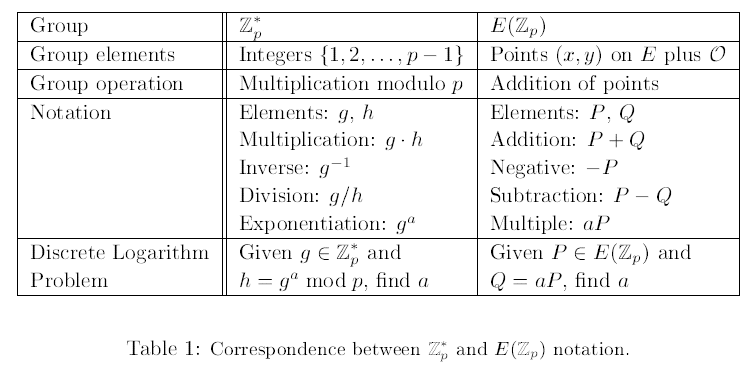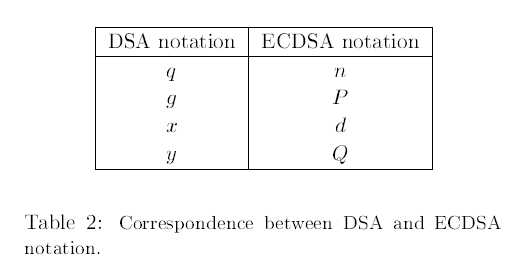关键词:
DSA:Digital Signature Algorithm (DSA)
ECDSA:The Elliptic Curve Digital Signature Algorithm (ECDSA)
DSS:Digital Signature Standard (DSS)
NIST:(U.S. National) Institute of Standards and Technology
FIPS:(U.S. Government) Federal Information Processing Standard
离散对数问题:discrete logarithm problem
欧拉函数:Φ(n)
欧拉定理:
主要内容:
- 密钥生成。key generation
- 签名生成。signature generation
- 签名验证。signature veri cation
1、DSA
- 密钥生成
1)、选择一个素数 q ,使得 2159 < q< 2160
2)、选择一个 1024-bit 的素数 p,属性为 q | p - 1。
(DSS 强制要求 p 是一个素数,使得 2511+64t < q< 2512+64t,当0 ≤ t ≤ 8。如果 t = 8,则 p 是一个 1024-bit 的素数。)
3)、选择一个元素 h ,h介于[ 1, p-1 ],然后计算 g = h(p- 1)/q mod p。重复直到 g ≠ 1。
4)、选择一个随机整数 x 在 [ 1,q - 1 ]。
5)、计算 y= gx mod p
6)、公钥是:(p,q,g,y);私钥是 x 。
对应openssl源码:
static int dsa_builtin_keygen(DSA *dsa)
{
int ok = 0;
BN_CTX *ctx = NULL;
BIGNUM *pub_key = NULL, *priv_key = NULL;
if ((ctx = BN_CTX_new()) == NULL)
goto err;
if (dsa->priv_key == NULL) {
if ((priv_key = BN_secure_new()) == NULL)
goto err;
} else
priv_key = dsa->priv_key;
do
if (!BN_rand_range(priv_key, dsa->q))
goto err;
while (BN_is_zero(priv_key)) ;
if (dsa->pub_key == NULL) {
if ((pub_key = BN_new()) == NULL)
goto err;
} else
pub_key = dsa->pub_key;
{
BIGNUM *prk = BN_new();
if (prk == NULL)
goto err;
BN_with_flags(prk, priv_key, BN_FLG_CONSTTIME);
if (!BN_mod_exp(pub_key, dsa->g, prk, dsa->p, ctx)) {
BN_free(prk);
goto err;
}
/* We MUST free prk before any further use of priv_key */
BN_free(prk);
}
dsa->priv_key = priv_key;
dsa->pub_key = pub_key;
ok = 1;
err:
if (pub_key != dsa->pub_key)
BN_free(pub_key);
if (priv_key != dsa->priv_key)
BN_free(priv_key);
BN_CTX_free(ctx);
return (ok);
}
- 签名生成
1)、选择一个随机整数 k ,k 介于[ 1,q - 1 ]。
2)、计算 r = (gk mod p) mod q。
3)、计算 k-1 mod q。
4)、计算 s = k-1 {h(m) + xr} mod q,h 是 安全哈希算法(SHA-1)。
5)、如果 s = 0,则转到 步骤 1)。
6)、签名信息 m 是 r 和 s 的组合(r,s)。
对应openssl中源码:
static DSA_SIG *dsa_do_sign(const unsigned char *dgst, int dlen, DSA *dsa)
{
BIGNUM *kinv = NULL;
BIGNUM *m;
BIGNUM *xr;
BN_CTX *ctx = NULL;
int reason = ERR_R_BN_LIB;
DSA_SIG *ret = NULL;
int rv = 0;
m = BN_new();
xr = BN_new();
if (m == NULL || xr == NULL)
goto err;
if (!dsa->p || !dsa->q || !dsa->g) {
reason = DSA_R_MISSING_PARAMETERS;
goto err;
}
ret = DSA_SIG_new();
if (ret == NULL)
goto err;
ret->r = BN_new();
ret->s = BN_new();
if (ret->r == NULL || ret->s == NULL)
goto err;
ctx = BN_CTX_new();
if (ctx == NULL)
goto err;
redo:
if (!dsa_sign_setup(dsa, ctx, &kinv, &ret->r, dgst, dlen))
goto err;
if (dlen > BN_num_bytes(dsa->q))
/*
* if the digest length is greater than the size of q use the
* BN_num_bits(dsa->q) leftmost bits of the digest, see fips 186-3,
* 4.2
*/
dlen = BN_num_bytes(dsa->q);
if (BN_bin2bn(dgst, dlen, m) == NULL)
goto err;
/* Compute s = inv(k) (m + xr) mod q */
if (!BN_mod_mul(xr, dsa->priv_key, ret->r, dsa->q, ctx))
goto err; /* s = xr */
if (!BN_add(ret->s, xr, m))
goto err; /* s = m + xr */
if (BN_cmp(ret->s, dsa->q) > 0)
if (!BN_sub(ret->s, ret->s, dsa->q))
goto err;
if (!BN_mod_mul(ret->s, ret->s, kinv, dsa->q, ctx))
goto err;
/*
* Redo if r or s is zero as required by FIPS 186-3: this is very
* unlikely.
*/
if (BN_is_zero(ret->r) || BN_is_zero(ret->s))
goto redo;
rv = 1;
err:
if (rv == 0) {
DSAerr(DSA_F_DSA_DO_SIGN, reason);
DSA_SIG_free(ret);
ret = NULL;
}
BN_CTX_free(ctx);
BN_clear_free(m);
BN_clear_free(xr);
BN_clear_free(kinv);
return ret;
}- 签名验证
1)、获取公钥(p,q,g,y)的真实副本。
2)、验证 r 和 s 是否为整数,且介于区间[ 1,q - 1 ]。
3)、计算 w = s-1 mod q 以及 h(m)。
4)、计算 u1 = h(m)w mod q 以及 u2 = rw mod q。
5)、计算 v = (gu1 yu2 mod p) mod q
6)、当且仅当 v = r,签名验证正确。
对应openssl源码:
static int dsa_do_verify(const unsigned char *dgst, int dgst_len,
DSA_SIG *sig, DSA *dsa)
{
BN_CTX *ctx;
BIGNUM *u1, *u2, *t1;
BN_MONT_CTX *mont = NULL;
const BIGNUM *r, *s;
int ret = -1, i;
if (!dsa->p || !dsa->q || !dsa->g) {
DSAerr(DSA_F_DSA_DO_VERIFY, DSA_R_MISSING_PARAMETERS);
return -1;
}
i = BN_num_bits(dsa->q);
/* fips 186-3 allows only different sizes for q */
if (i != 160 && i != 224 && i != 256) {
DSAerr(DSA_F_DSA_DO_VERIFY, DSA_R_BAD_Q_VALUE);
return -1;
}
if (BN_num_bits(dsa->p) > OPENSSL_DSA_MAX_MODULUS_BITS) {
DSAerr(DSA_F_DSA_DO_VERIFY, DSA_R_MODULUS_TOO_LARGE);
return -1;
}
u1 = BN_new();
u2 = BN_new();
t1 = BN_new();
ctx = BN_CTX_new();
if (u1 == NULL || u2 == NULL || t1 == NULL || ctx == NULL)
goto err;
DSA_SIG_get0(sig, &r, &s);
if (BN_is_zero(r) || BN_is_negative(r) ||
BN_ucmp(r, dsa->q) >= 0) {
ret = 0;
goto err;
}
if (BN_is_zero(s) || BN_is_negative(s) ||
BN_ucmp(s, dsa->q) >= 0) {
ret = 0;
goto err;
}
/*
* Calculate W = inv(S) mod Q save W in u2
*/
if ((BN_mod_inverse(u2, s, dsa->q, ctx)) == NULL)
goto err;
/* save M in u1 */
if (dgst_len > (i >> 3))
/*
* if the digest length is greater than the size of q use the
* BN_num_bits(dsa->q) leftmost bits of the digest, see fips 186-3,
* 4.2
*/
dgst_len = (i >> 3);
if (BN_bin2bn(dgst, dgst_len, u1) == NULL)
goto err;
/* u1 = M * w mod q */
if (!BN_mod_mul(u1, u1, u2, dsa->q, ctx))
goto err;
/* u2 = r * w mod q */
if (!BN_mod_mul(u2, r, u2, dsa->q, ctx))
goto err;
if (dsa->flags & DSA_FLAG_CACHE_MONT_P) {
mont = BN_MONT_CTX_set_locked(&dsa->method_mont_p,
dsa->lock, dsa->p, ctx);
if (!mont)
goto err;
}
if (dsa->meth->dsa_mod_exp != NULL) {
if (!dsa->meth->dsa_mod_exp(dsa, t1, dsa->g, u1, dsa->pub_key, u2,
dsa->p, ctx, mont))
goto err;
} else {
if (!BN_mod_exp2_mont(t1, dsa->g, u1, dsa->pub_key, u2, dsa->p, ctx,
mont))
goto err;
}
/* let u1 = u1 mod q */
if (!BN_mod(u1, t1, dsa->q, ctx))
goto err;
/*
* V is now in u1. If the signature is correct, it will be equal to R.
*/
ret = (BN_ucmp(u1, r) == 0);
err:
if (ret < 0)
DSAerr(DSA_F_DSA_DO_VERIFY, ERR_R_BN_LIB);
BN_CTX_free(ctx);
BN_free(u1);
BN_free(u2);
BN_free(t1);
return (ret);
}
2、ECDSA
- 密钥生成
1)、选择一个定义在 Zp 上的椭圆曲线 E 。E(Zp) 中点的个数应该被一个大素数 n 整除。
2)、选择一个点 P ∈ E(Zp),(n 阶)。
3)、选择一个统计学上的独特和不可预测的整数 d ,介于 [ 1,n - 1 ]。
4)、计算 Q = dP。
5)、公钥是:(E,P,n,Q);私钥是 d 。
- 签名生成
1)、选择一个统计学上的独特和不可预测的整数 k ,介于 [ 1,n - 1 ]。
2)、计算 kP = (x1, y1) 以及 r = x1 mod n。(这里被认为是一个整数,例如从二进制表示转换)。如果 r = 0,则转到步骤 1)。
3)、计算 k-1 mod n。
4)、计算 s = k-1 { h(m) + dr } mod n,h 是 安全哈希算法(SHA-1)。
5)、如果 s = 0,则转到 步骤 1)。
6)、签名信息 m 是 r 和 s 的组合(r,s)。
- 签名验证
1)、获取公钥(E,P,n,Q)的真实副本。
2)、验证 r 和 s 是否为整数,且介于区间[ 1,n - 1 ]。
3)、计算 w = s-1 mod n 以及 h(m)。
4)、计算 u1 = h(m)w mod n 以及 u2 = rw mod n。
5)、计算u1P + u2Q = (x0, y0) 以及 v = x0 mod n。
6)、当且仅当 v = r,签名验证正确。



























 1678
1678

 被折叠的 条评论
为什么被折叠?
被折叠的 条评论
为什么被折叠?








